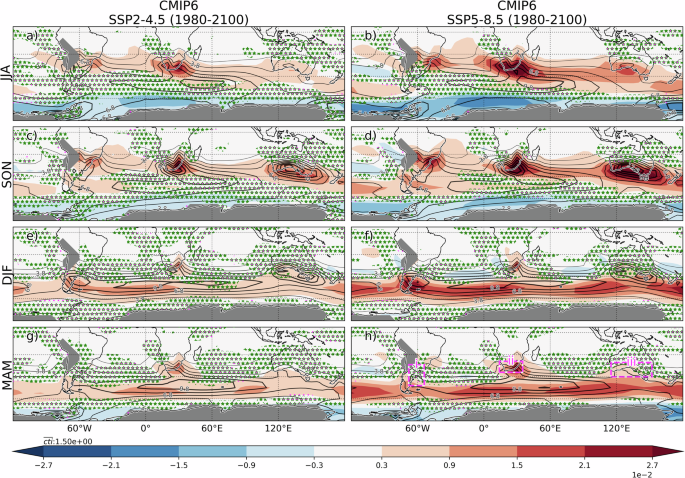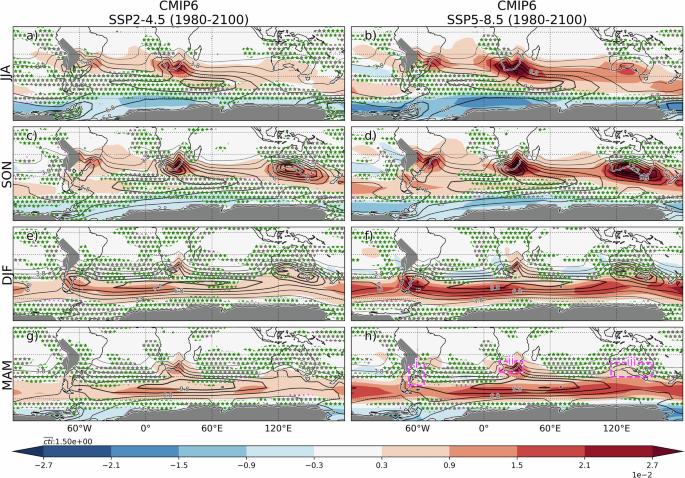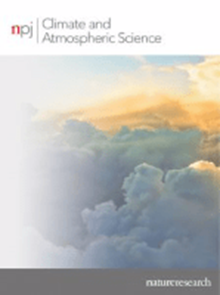南半球热带外陆块上空亚周温度变化的季节性放大
IF 8.5
1区 地球科学
Q1 METEOROLOGY & ATMOSPHERIC SCIENCES
引用次数: 0
摘要
气温变化与极端高温的频率和严重程度有关,对社会经济有重大影响。在人类活动的影响下,气候模式预测南半球某些地区的近地面温度变率会随季节变化而放大,而且近几十年来已经观测到了强劲的正向趋势。在这里,我们展示了耦合模式相互比较项目(CMIP6)第六阶段的多模式集合平均值在南非、澳大利亚和南美洲模拟的副周气温变率的放大作用通常比近几十年的再分析要小得多,只有在 21 世纪末才达到类似的放大作用,原因是副周变率生成效率的放大作用较弱。对一个大型模式集合的分析表明,这种差异可能是由于内部气候变异造成的,这表明最近在再分析中看到的快速放大可能会放缓,甚至在不久的将来暂时逆转。本文章由计算机程序翻译,如有差异,请以英文原文为准。


Seasonal amplification of subweekly temperature variability over extratropical Southern Hemisphere land masses
Temperature variability has substantial socioeconomic impacts through its association with the frequency and severity of heat extremes. Under anthropogenic influence, climate models project seasonally-dependent amplifications of near-surface temperature variability over some sectors of the Southern Hemisphere, and robust positive trends have already been observed in recent decades. Here we show that the amplification of subweekly temperature variability simulated by the multi-model ensemble mean of the sixth phase of the Coupled Model Intercomparison Project (CMIP6) over South Africa, Australia, and South America is often substantially smaller than in reanalyses in recent decades, reaching a similar amplification only at the end of the 21st century due to a weaker amplification of subweekly variance generation efficiency. Analysis of a large model ensemble indicates that this discrepancy may be due to internal climatic variability suggesting that the recent rapid amplification seen in reanalyses may slow down or even temporarily reverse in the near future.
求助全文
通过发布文献求助,成功后即可免费获取论文全文。
去求助
来源期刊

npj Climate and Atmospheric Science
Earth and Planetary Sciences-Atmospheric Science
CiteScore
8.80
自引率
3.30%
发文量
87
审稿时长
21 weeks
期刊介绍:
npj Climate and Atmospheric Science is an open-access journal encompassing the relevant physical, chemical, and biological aspects of atmospheric and climate science. The journal places particular emphasis on regional studies that unveil new insights into specific localities, including examinations of local atmospheric composition, such as aerosols.
The range of topics covered by the journal includes climate dynamics, climate variability, weather and climate prediction, climate change, ocean dynamics, weather extremes, air pollution, atmospheric chemistry (including aerosols), the hydrological cycle, and atmosphere–ocean and atmosphere–land interactions. The journal welcomes studies employing a diverse array of methods, including numerical and statistical modeling, the development and application of in situ observational techniques, remote sensing, and the development or evaluation of new reanalyses.
 求助内容:
求助内容: 应助结果提醒方式:
应助结果提醒方式:


